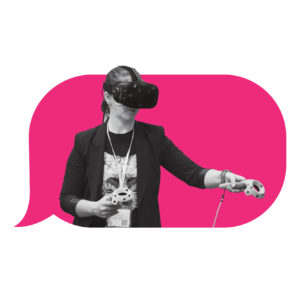 One of the paradoxes of virtual reality (VR) is that the immersive technology has the ability to isolate people from each other in a local space. Once you’ve put on a VR headset and begun to interact with a digitized reality, you’re no longer sharing experience with the people around you in the same way.
One of the paradoxes of virtual reality (VR) is that the immersive technology has the ability to isolate people from each other in a local space. Once you’ve put on a VR headset and begun to interact with a digitized reality, you’re no longer sharing experience with the people around you in the same way.
“If I put on a headset while I’m standing in a group of people, I exclude all the people around me,” said Dave Lorenzini, founder of Event FX, a company that specializes in bringing augmented reality (AR), VR, and other visual technology to clients that include event organizers, trade shows, and venues. “It’s inherently antisocial.” But the flip side of that is social VR, which brings people who are isolated in different places together in the same virtual space. “Maybe [when I put on a headset],” Lorenzini said, “I’ve just joined a virtual community of a million people who are all connected.”
Social VR is “late to the party, and not that many people know about it,” according to Lorenzini. One example is Facebook Spaces, a virtual 3D environment that the social-media giant launched in beta last year. While Facebook’s use of the technology to virtually highlight disaster-relief efforts in Puerto Rico last fall fell flat, Lorenzini is confident that social VR will have a transformative effect on events. VR “is the ultimate storytelling tool,” he said. “You can transport your audiences anywhere, real or imagined, and you can make people feel things in ways which you can’t really do with videos or other kinds of things.”
There’s tons of care and feeding … it’s a real pain to make VR experiences happen.
Although the future of virtual reality is “very bright, ” for now VR is operating under what Lorenzini calls the “fog of friction.” There’s “tons of care and feeding and setup and configuration that you have to do — it’s a real pain — to make VR experiences happen,” said Lorenzini, who as we spoke was unloading backpacks filled with equipment and cables at The Future of Face2Face space at PCMA Convening Leaders 2018 in Nashville last month. “It’ll be very big, but it’s an industry still struggling for scale.”
Lorenzini expects that to change as companies introduce less expensive, more accessible equipment and tools, beginning this year. But it would be a mistake however to focus too much on the hardware. “You can’t think of virtual reality as any device,” Lorenzini said. “It’s not a thing you put on your head. It’s a new way to communicate.”
What’s possible right now? “Number one, every event should have at least one 360-degree livestream coming from the event to Facebook Live, because that will allow anyone who’s not there to get a personal experience,” Lorenzini said. “The power of this stuff is personalization. It’s not like watching a video — you can turn your head and look at whatever you want to look at, so that’s a big thing.” For a look at what’s possible with 360-degree VR, join Facebook’s 360 group or visit veer.tv.
“There’s no talking about AR/VR,” Lorenzini added. “It’s an experience. You have to put on the headset, look through the glasses, do something. It’s really hard to write an article about AR/VR, because you have to challenge people to try it.”
Read more digital-event stories from our CMP Series “Screen Time.”